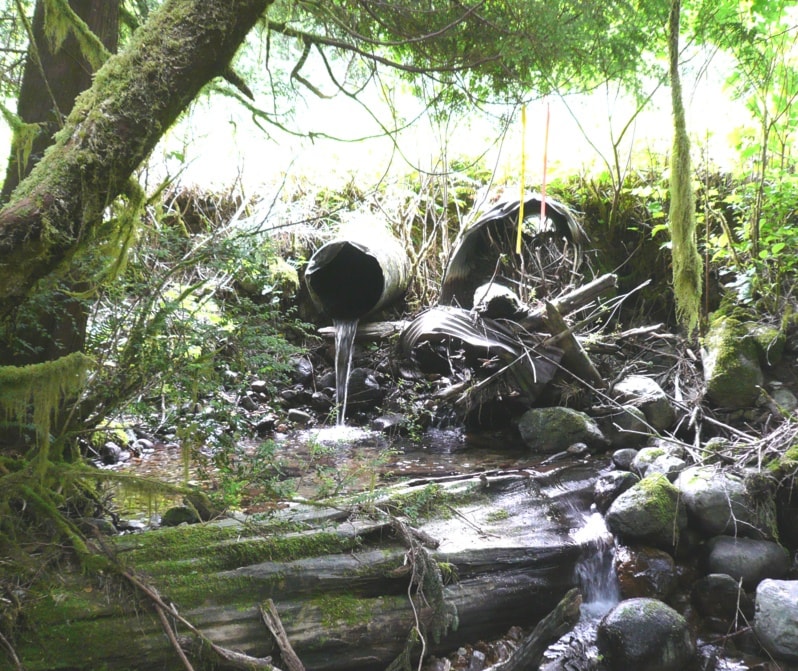The Central Westcoast Forest Society will reunite local fish with long lost rearing and spawning habitats by replacing three culverts this summer.
Two culverts will be replaced under Hwy 4 in the Conference Creek Watershed near the Kennedy Lake boat launch and the third will be replaced under the Pacific Rim Highway in the English Cove Watershed near Tofino.
“Hopefully, once these culverts are replaced and the connectivity of these streams are restored the fish will have access to increased spawning and rearing habitat upstream that has not been accessible since the road was constructed in the 1950’s,†said CWFS executive director Jessica Hutchinson.
“This should really be a boost to local wild salmon populations...We hope that this year is just the start of a bigger project to come next year where we’re addressing even more culverts in a single season.â€
Culverts are tunnels placed under roadways to allow streams to flow through but the West Coast’s culverts weren’t installed with fish in mind, according to Hutchinson.
“Unfortunately, when the highways and the roads out here were constructed, they didn’t really pay much attention to fish habitat or maintaining stream connectivity. Basically the roads were constructed without a thought for fish,†she said.
“What we have is a network of roads and highways that create barriers to fish migration.â€
She said some local culverts are too narrow for wide channels to feed into and others are too high for fish to travel through.
“Sometimes the culvert will be so small and the water so fast that it’s basically like a fire hose and the fish can’t make it through because...it doesn’t have the physical capacity to swim through a culvert that’s pushing water at that fast of a flow,†Hutchinson said.
She said the three new culverts CWFS is set to install would be wide enough to maintain natural channel flows.
“The culvert will be so big that the creek will flow through it as if it never even entered the culvert; it will just be a continual natural habitat...as opposed to being constricted or funneled or segmented by a culvert,†she said.
The CWFS has identified about 12 culverts in the English Cove Watershed that must be replaced and about 14 more in the Conference Creek watershed.
“Central Westcoast has identified a whole series of fish barriers that exist on Highway 4 and we’re working with the ministry of transportation to address these culverts one by one replacing them with fish friendly culverts,†Hutchinson said.
“Basically that means tearing up the road, excavating out the old culvert, and putting in a new giant culvert that will allow for not only fish passage but also amphibian and small mammal passage as well.â€
Work to replace two culverts under Hwy 4 will kick off around Aug. 5 and drivers can expect delays for about three weeks. Pacific Rim Highway commuters can expect delays near Maltby Road for about two weeks between late August and early September while the third culvert is being installed.
The work will run up an estimated $800,000 tab and be paid for by about $500,000 from BC’s ministry of transportation and about $290,000 from funds the CWFS raised through the Department of Fisheries and Oceans Canada, the Alberni Clayoquot Regional District and the Pacific Salmon Foundation.
Hutchinson was stoked to find such significant support for the project.
“We’re really excited that the ministry has come on board and that we’re partnering with all these different groups to bring this to fruition and we hope to see some really positive results in our monitoring efforts in terms of increased fish populations,†she said.
“Reconnecting fish habitat is one of the most effective restoration practices for boosting wild salmon populations.â€
She added that degraded culverts under highways are hazardous to human safety and noted the culvert collapse under Grice Bay Road that caused a sink-hole-like hazard earlier this year.
She suggested a culvert collapse under Hwy 4 or the Pacific Rim Hwy could cut off communities.
“These culverts are all starting to go because that highway was constructed that long ago so we’re going to see a continued number of culverts collapse in the coming years,†she said.
“It’s really important from a safety perspective to address them and replace them before we have a collapsed culvert that cuts off access 100 per cent and this becomes more of an emergency situation.â€
Andrew.bailey@westerlynews.ca
